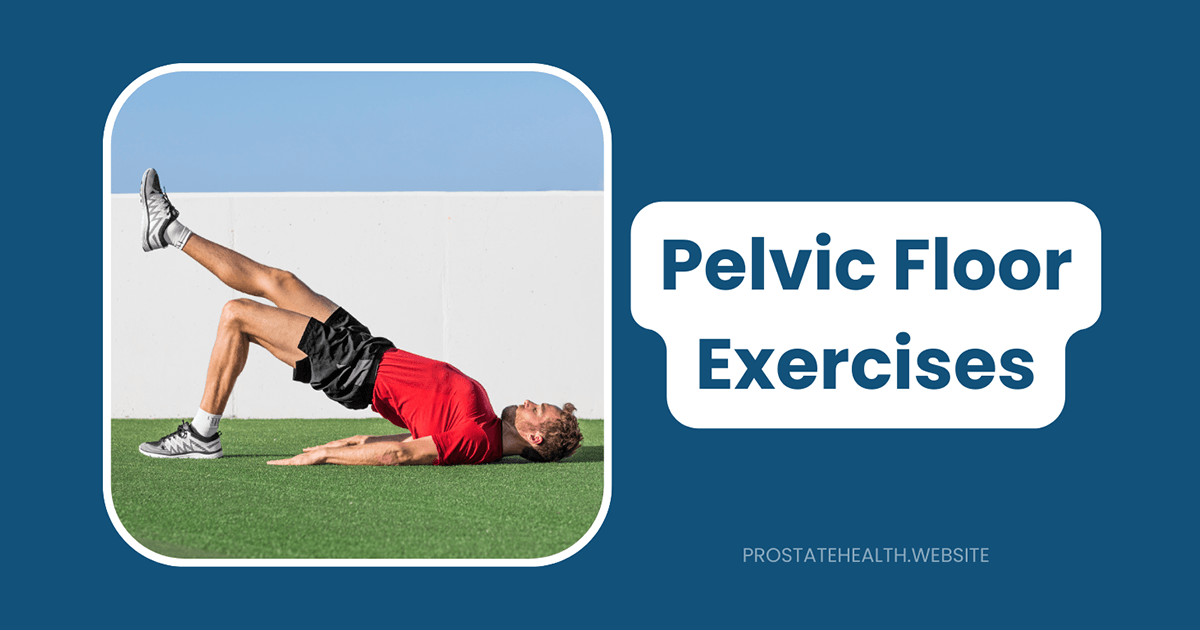Pelvic Floor Exercises for Men: A Step-by-Step Guide

When Mark, a 58-year-old construction manager, first heard about pelvic floor exercises from his urologist, he was skeptical. “I thought these were just for women after childbirth,” he admits. “I had no idea these muscles were so important for men’s health too.”
Mark isn’t alone. Many men are unaware of their pelvic floor muscles—a hammock-like layer of muscles stretching from the pubic bone to the tailbone—and the crucial role they play in urinary control, bowel function, and sexual health. Yet strengthening these muscles can provide significant benefits, from preventing embarrassing leakage to improving sexual performance.
Whether you’re dealing with urinary issues after prostate surgery, experiencing erectile difficulties, or simply want to maintain optimal pelvic health as you age, this comprehensive guide will walk you through everything you need to know about pelvic floor exercises for men.
Understanding Your Pelvic Floor: The Foundation of Men’s Health
Before diving into exercises, it’s important to understand what the pelvic floor is and why it matters.
What Is the Pelvic Floor?
The pelvic floor is a group of muscles and tissues that form a supportive sling at the base of your pelvis. In men, these muscles:
- Support the bladder, prostate, and rectum
- Help control urination and bowel movements
- Play a crucial role in sexual function, including erections and ejaculation
- Contribute to core stability and posture
The main pelvic floor muscles include:
- Levator ani: The largest group of pelvic floor muscles
- Coccygeus: Helps support pelvic organs
- Bulbocavernosus: Surrounds the bulb of the penis and aids in ejaculation
- Ischiocavernosus: Helps maintain erections
- External anal sphincter: Controls bowel movements
Why Pelvic Floor Health Matters for Men
Many factors can weaken the pelvic floor muscles, including:
- Aging
- Prostate surgery
- Chronic constipation
- Persistent coughing
- Being overweight
- Lack of physical activity
- High-impact activities
When these muscles weaken, men may experience:
- Urinary incontinence: Leaking urine when coughing, sneezing, or exercising
- Post-void dribble: Leaking after urination
- Erectile dysfunction: Difficulty achieving or maintaining erections
- Premature ejaculation: Reduced control over ejaculation
- Fecal incontinence: Difficulty controlling bowel movements
According to the Cleveland Clinic, strengthening these muscles through regular exercises can prevent or improve many of these issues, enhancing quality of life and confidence.
The Benefits of Pelvic Floor Exercises for Men
Research has demonstrated numerous benefits of pelvic floor exercises for men:
Improved Urinary Control
- Reduced leakage: Studies show that regular pelvic floor exercises can significantly reduce urinary incontinence, particularly after prostate surgery
- Less frequent urination: Strengthening these muscles can help reduce urinary frequency and urgency
- Decreased post-void dribble: Many men report less dribbling after urination
According to a study published in PMC, men who performed high-intensity pelvic floor training after prostate surgery had significantly better continence rates, with 74% achieving full continence at 3 months compared to 43% in the control group.
Enhanced Sexual Function
- Better erectile function: Stronger pelvic floor muscles can improve blood flow to the penis, potentially enhancing erections
- Improved ejaculatory control: These exercises may help men who experience premature ejaculation
- Increased sexual satisfaction: Many men report more intense orgasms after regular pelvic floor training
The Urology Group notes that Kegel exercises can help men achieve and maintain erections and may serve as a first-line therapy for erectile dysfunction, which affects approximately 30 million men in the United States.
Prostate Health Support
- Reduced symptoms of BPH: Some men with benign prostatic hyperplasia (enlarged prostate) report improved symptoms
- Faster recovery after surgery: Starting pelvic floor exercises before prostate surgery can lead to faster recovery of continence afterward
- Management of prostatitis symptoms: These exercises may help relieve symptoms of chronic prostatitis/chronic pelvic pain syndrome
Core Stability and Overall Health
- Improved core strength: The pelvic floor works with abdominal and back muscles to support the spine
- Better posture: Strong pelvic floor muscles contribute to proper alignment
- Reduced risk of hernias: These exercises may help prevent certain types of hernias
Finding Your Pelvic Floor Muscles: The First Step
Before you can strengthen these muscles, you need to identify them correctly. Here are three proven methods:
Method 1: The Stop-Flow Technique
- During urination, try to stop or slow your urine stream midflow
- The muscles you use to do this are your pelvic floor muscles
- Important: Use this technique only for identification purposes, not as a regular exercise, as it can potentially lead to urinary dysfunction if done repeatedly
Method 2: The Mirror Check
- Stand naked in front of a mirror
- Without using other muscles (buttocks, thighs, or abdomen), try to lift your penis and testicles
- You should see movement in your penis and scrotum
- If your abdomen moves inward significantly, you’re likely engaging your abdominal muscles too much
Method 3: The Digital Check
- While lying down or sitting, place a finger on the area between your scrotum and anus (the perineum)
- Tighten your pelvic floor muscles as if stopping urine flow
- You should feel the perineum lift upward against your finger
- If done correctly, you’ll feel a lifting and tightening sensation
Dr. James Thompson, a urologist at University Medical Center, explains: “Many men initially contract the wrong muscles—usually the abdominals, buttocks, or thigh muscles. The key is to isolate just the pelvic floor muscles, which takes practice and awareness.”
Basic Pelvic Floor Exercise Routine: The Foundation
Once you’ve identified your pelvic floor muscles, you can begin a basic strengthening routine:
The Basic Contraction (Kegel Exercise)
- Get comfortable: Start in a lying position, which makes it easier to focus on the correct muscles
- Contract: Tighten your pelvic floor muscles for 3-5 seconds (imagine lifting and squeezing as if stopping urine flow)
- Relax: Completely relax the muscles for 3-5 seconds (relaxation is just as important as contraction)
- Repeat: Perform 10 repetitions
- Frequency: Do this 3 times daily (morning, afternoon, evening)
Progression Tips
- Gradually increase hold time: Work up to holding contractions for 10 seconds
- Increase repetitions: Build up to 15-20 repetitions per set
- Change positions: Progress from lying to sitting to standing
- Add functional movements: Eventually perform while walking or during daily activities
According to Mayo Clinic, most men should aim for at least 30 to 40 Kegel exercises daily, spread throughout the day.
Advanced Pelvic Floor Exercises: Building Strength and Control
Once you’ve mastered the basics, try these advanced techniques to further strengthen your pelvic floor:
Quick Flicks
- Contract your pelvic floor muscles quickly
- Release immediately
- Repeat 10-15 times
- Perform 3 sets daily
This exercise helps improve the reactivity of your pelvic floor muscles, which is particularly helpful for preventing leakage during sudden movements like coughing or sneezing.
The Elevator
- Imagine your pelvic floor as an elevator
- Slowly contract your muscles as if the elevator is rising floor by floor (3-4 levels)
- Hold at the “top floor” for 3-5 seconds
- Slowly “descend” floor by floor until fully relaxed
- Repeat 5-10 times, 3 times daily
This exercise helps develop better control and awareness of different levels of contraction.
The Bridge with Pelvic Floor Activation
- Lie on your back with knees bent and feet flat on the floor
- Engage your pelvic floor muscles
- While maintaining the contraction, lift your hips off the floor
- Hold for 3-5 seconds
- Lower your hips while keeping pelvic floor engaged
- Relax completely
- Repeat 10 times
This exercise integrates pelvic floor activation with core and gluteal strengthening.
Functional Integration
- Practice engaging your pelvic floor before and during activities that typically cause leakage (coughing, sneezing, lifting)
- Maintain the contraction throughout the activity
- Release afterward
This technique, sometimes called “The Knack,” can significantly reduce stress incontinence during daily activities.
Position-Specific Exercises: Targeting Different Aspects of Pelvic Health
Different positions can help target specific aspects of pelvic floor function. The Urology Group recommends these three approaches:
The Back Approach (For Overall Strengthening)
- Lie on your back with knees bent and feet flat
- Draw the penis inward (imagine trying to make it shorter)
- Simultaneously squeeze the anus as if preventing gas
- Hold for 5 seconds, then relax
- Repeat 8-10 times for 3-5 sets daily
The Side Approach (For Erectile Function)
- Lie on your side with a pillow between your knees
- Squeeze your legs together while engaging pelvic floor muscles
- Hold for 5 seconds, then relax
- Repeat 8-10 times for 3-5 sets daily
This approach particularly targets the ischiocavernosus and bulbocavernosus muscles, which play a key role in erectile function.
The Chair Approach (For Practical Integration)
- Sit comfortably in a chair with good posture
- Squeeze the pelvic floor muscles as if stopping urine flow
- Hold for 5 seconds, then relax
- Repeat 8-10 times for 3-5 sets daily
This position is practical for incorporating exercises into your daily routine, such as while at work or watching TV.
Special Considerations for Specific Conditions
For Men After Prostate Surgery
Prostate surgery, particularly radical prostatectomy, often leads to temporary or persistent urinary incontinence. According to Prostate Cancer UK, pelvic floor exercises can significantly improve recovery:
- Start before surgery: Begin exercises 4-6 weeks before surgery if possible
- Resume after catheter removal: Once your catheter is removed, restart gentle exercises
- Be patient: Improvement typically takes 3-6 months of consistent practice
- Consider professional guidance: A pelvic floor physical therapist can provide personalized instruction
Research shows that men who perform pelvic floor exercises before and after prostate surgery regain continence faster than those who don’t.
For Erectile Dysfunction
Pelvic floor exercises can be a non-invasive approach to improving erectile function:
- Focus on the bulbocavernosus muscle: This muscle surrounds the base of the penis and helps maintain erections
- Consistency is key: Improvements typically require 4-6 weeks of regular practice
- Combine with other approaches: These exercises work well alongside other treatments for ED
For Premature Ejaculation
Strengthening the pelvic floor can help improve control over ejaculation:
- Focus on quick contractions and releases: This helps develop better control
- Practice during self-stimulation: Learn to recognize the point of no return and contract muscles to delay ejaculation
- Be patient: Results typically take several weeks to months
Common Mistakes and How to Avoid Them
Even with the best intentions, many men make these common mistakes when performing pelvic floor exercises:
Mistake 1: Engaging the Wrong Muscles
Problem: Contracting abdominal, buttock, or thigh muscles instead of pelvic floor muscles.
Solution:
- Focus on isolating just the pelvic floor muscles
- Check in a mirror to ensure your abdomen remains relatively flat
- Place a hand on your abdomen to detect unwanted movement
Mistake 2: Holding Your Breath
Problem: Many men unconsciously hold their breath during pelvic floor contractions.
Solution:
- Consciously maintain normal breathing throughout exercises
- Practice coordinating contractions with exhalation
Mistake 3: Inconsistent Practice
Problem: Doing exercises sporadically rather than regularly.
Solution:
- Set specific times for exercises (e.g., after brushing teeth, during commercials)
- Use smartphone reminders
- Track your progress to stay motivated
Mistake 4: Overtraining
Problem: Doing too many exercises too quickly can lead to muscle fatigue or pain.
Solution:
- Start with fewer repetitions and gradually increase
- Ensure complete relaxation between contractions
- If you experience pain, reduce intensity and consult a healthcare provider
Mistake 5: Expecting Immediate Results
Problem: Becoming discouraged when improvements aren’t immediate.
Solution:
- Understand that results typically take 6-12 weeks
- Keep a journal to track subtle improvements
- Remember that consistency is more important than intensity
Creating a Sustainable Routine: Making Exercises Part of Daily Life
The key to success with pelvic floor exercises is consistency. Here’s how to make them a sustainable part of your routine:
Link to Daily Activities
Associate exercises with regular daily activities:
- During your morning shower
- While brushing your teeth
- At traffic lights while driving
- During commercials while watching TV
- While waiting in line
Use Technology
- Set smartphone reminders
- Try apps specifically designed for pelvic floor exercises, like the Squeezy App recommended by Prostate Cancer UK
- Use wearable devices or biofeedback tools for more advanced training
Track Your Progress
- Keep a simple log of exercises completed
- Note improvements in symptoms
- Celebrate milestones (e.g., first day without leakage)
Make It Social
- Join online forums or support groups
- Share your journey with a trusted friend or partner
- Consider group pelvic floor therapy sessions
When to Seek Professional Help
While pelvic floor exercises can be done independently, certain situations warrant professional guidance:
Consider seeing a pelvic floor physical therapist if:
- You’re unsure if you’re performing exercises correctly
- You experience pain during exercises
- You see no improvement after 6-8 weeks of consistent practice
- You have severe incontinence or erectile dysfunction
- You’re preparing for or recovering from prostate surgery
According to ZERO Cancer, pelvic floor physical therapy is often underutilized for men recovering from prostate cancer in the U.S., yet it can provide significant benefits beyond self-directed exercises.
A pelvic floor physical therapist can:
- Verify you’re targeting the correct muscles
- Provide biofeedback training to improve technique
- Develop a personalized exercise program
- Address related issues like core weakness or posture problems
- Offer advanced techniques for specific conditions
Success Stories: Real Men, Real Results
While individual results vary, many men report significant improvements from regular pelvic floor exercises:
Robert, 65, post-prostatectomy recovery: “After my prostate was removed, I had significant leakage issues. I started pelvic floor exercises three times daily, and within three months, I was down to just occasional minor leaks. By six months, I was completely dry again. These exercises gave me my confidence back.”
Michael, 48, premature ejaculation: “I was skeptical that exercises could help with premature ejaculation, but after about two months of consistent practice, I noticed I had much better control. My relationship has improved significantly as a result.”
James, 72, post-void dribble: “The dribbling after urination was embarrassing and frustrating. Since starting these exercises, it’s almost completely gone. Such a simple solution to what was affecting my quality of life.”
Conclusion: A Simple Practice with Powerful Benefits
Pelvic floor exercises represent one of the most accessible, cost-effective approaches to improving multiple aspects of men’s health. Whether you’re dealing with urinary issues, sexual concerns, or simply want to maintain optimal pelvic health as you age, these exercises offer significant benefits with minimal risk.
As with any exercise program, the key is consistency and proper technique. Start slowly, focus on quality over quantity, and give your body time to respond. Most men notice improvements within 6-12 weeks of regular practice.
Remember Mark, the construction manager we met at the beginning? Six months after starting pelvic floor exercises, he reports: “My urinary control is better than it’s been in years, and there have been unexpected benefits in the bedroom too. I just wish someone had told me about these exercises decades ago.”
It’s never too early—or too late—to start strengthening these crucial muscles. Your future self will thank you.






